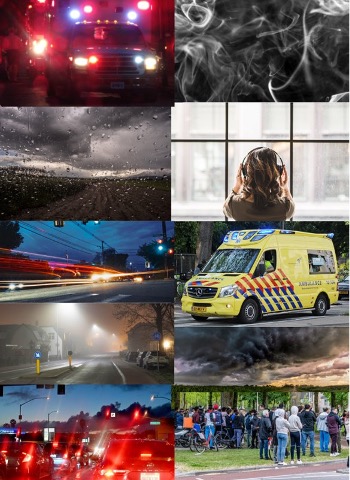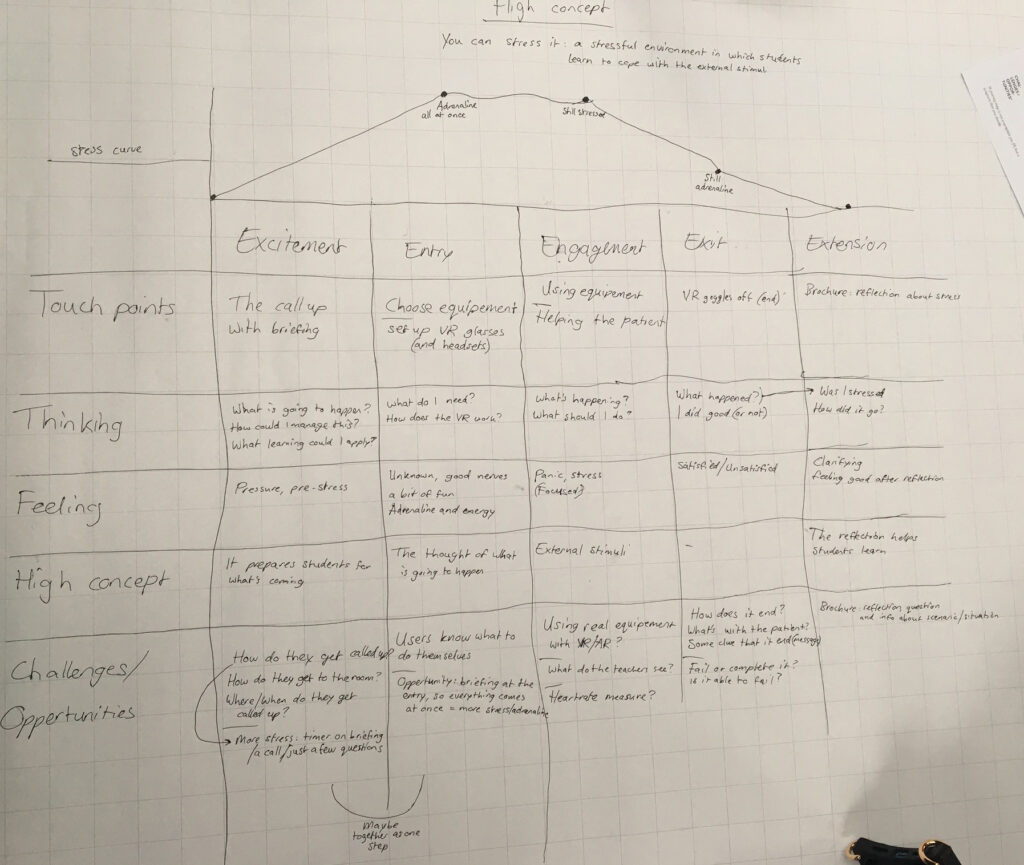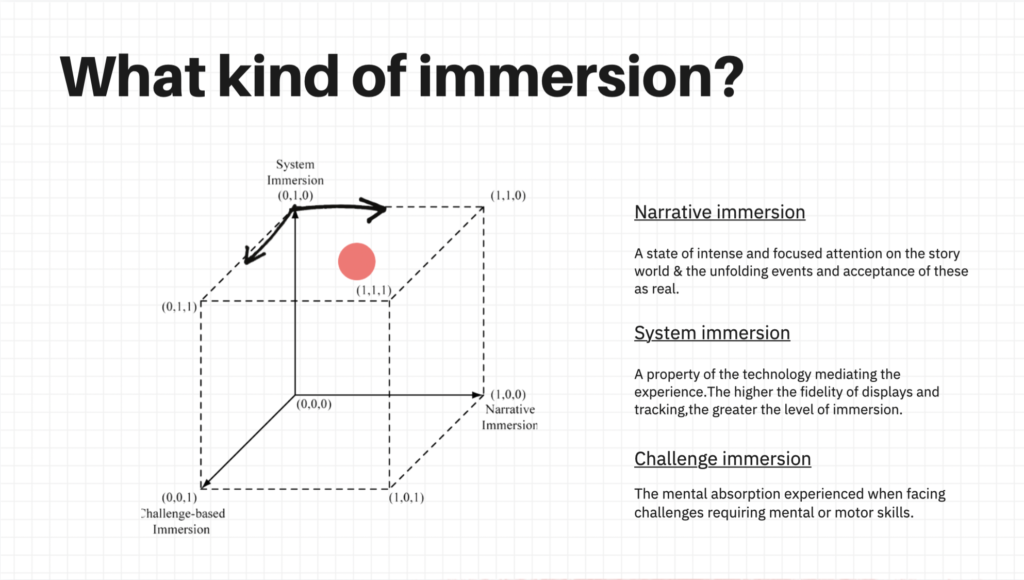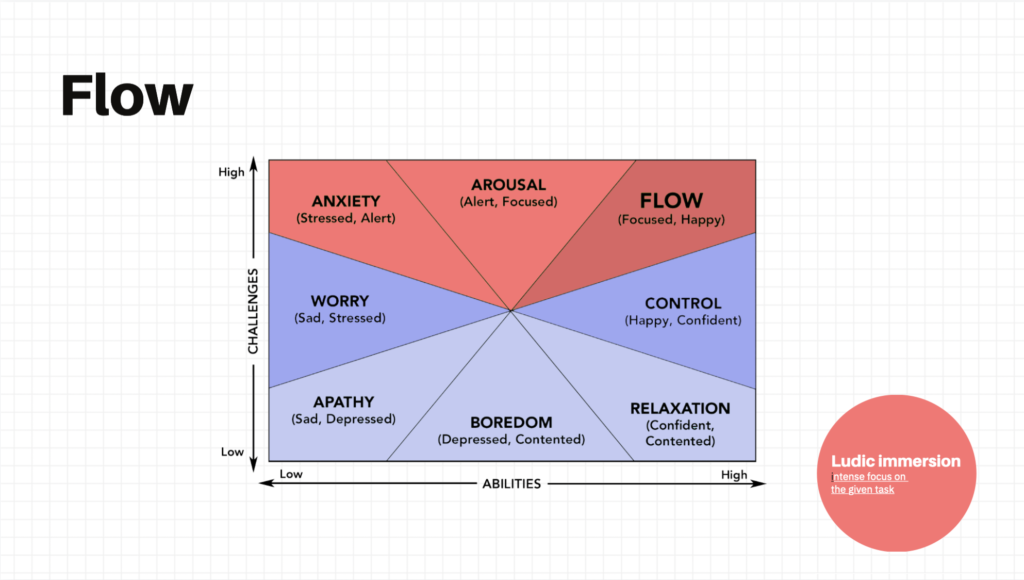Problem
Students of emergency care are not well prepared going into the real working field, they often get shocked under the working circumstances.
Solution
To help students of the medical care program deal with stress, we created an environment full of external stimuli in which students can experience how this influences their performances.
This is about creating an Immersive Experience to help students of the medical care program deal with stress. We are creating an environment full of external stimuli in which students can experience how this influences their performances.
We do this so the students will be more prepared for their internships and will be able to perform correctly in their field of practice.
Vision: Creating an environment in which students can experience in which way external stimuli influences their performance.
Mission: Through this environment students learn how to deal with the stress of the external stimuli.
The concept we were working with was “You can stress it”. For this concept we wanted to focus on what the environment can do to make the student more stressful.

There is a male laying on the floor, he got a heart attack. What do you have to do?
This is the start of the immersive learning environment.
How to make this al work? We divided our experience into different frames, so it is better to understand the why and how we want to implement the elements in the experience.
Research
Why do reactions to stress vary from person to person?
Because everyone reacts to it with their own strengths and weaknesses. The reaction depends on the physical state (tired or rested), the emotional state (serene or “on edge”), the mental state (relaxed or preoccupied) or the possibility of acting or not on the causes of the stress, of controlling it, of accepting it, etc.
What is stress?
The word “stress” is part of our everyday language. We regularly use it to refer to our emotions to designate our emotional reactions to the difficulties of life. We it is often qualified as good or bad, depending on whether it is experienced as a “motor” or as a “brake”.
Situations that lead to high stress hormone production have at least one of the following characteristics:
- one has the impression of not having control over the situation (low control)
- the situation is unpredictable (unpredictability)
- this situation is new (novelty) – the ego must feel threatened (personality)
We also attended “Disaster Day”. A staged rescue to practice the students in real life conditions. The injured are played by actors and the students must rescue them. This staging allowed us to really live an emergency and better understand the stress factors in these moments.



In order to exercise the students in the best possible way, we have thought of different levels in our scenarios. Here is the level 2 on which we worked:
« We are in the city center of Utrecht, on a tuesday evening at 6:30 pm. Family X has started to cook the meal for their dinner. They realize that they are missing eggs to finish the recipe. The mother decides to go quickly to the supermarket down the street to buy some. In the meantime, the father and the child of the family continue to cook together. Fifteen minutes later the mother is back in the apartment. But disaster, she found her husband lying on the floor and her child next to him, he was in shock and crying. Distraught, she tried to understand what was going on, but the child was unable to explain. She then takes her phone and quickly calls the emergency room. An ambulance is then sent to their home to rescue the father of the family. »
Critical points
Entry
Users could be called up through a walkie talkie, just like they use in real life. The ambulance jackets are also an important part, this in combination with stepping in a room makes users feel like they step into another world and another room.
Beforehand it is important that the students don’t know what is going to happen. Therefore, everything happens and comes to you at once while entering the experience (if you don’t know what is going to happen you got more stressed). The levels also help with this. Reading the briefing while driving the ambulance is also just like in real life.
Sound
In the experience there is sound used by the normal things you will hear in the living room like the tv that is still on, a dog barking, the fridge and/or white noise.
But sounds could also be people talking, screaming, or crying so the students will learn how to deal with bystanders and patients making noise. While doing interviews it became clear that other people talking, either bystanders or patients, where one of the most distracting and stressful factors. An interesting part could also be adding sounds from the users themselves or what they could think. Hearing a heartbeat (your own) for instance is related to stress and hearing a timer ticking makes you think of a deadline. Another sound could be the walkie talkie that makes noise and/or someone talking to you through it. These could also invoke extra stress.
VR
Part of the immersive experience will take place in a VR world. This means that as a student you feel like they are at a real location with a real patient, they will get more immersed.
VR is also handy in the different levels we want to offer. It makes it possible to have lots of different levels in one room.
In the simulation we had a male character with tattoos who was quite muscular and a child crying. The characters were made to be realistic and were fully clothed. For later levels there could be a variety between the patients (weight difference, racial tones and aggressive patients). This would make the situation more stressful.
Smell
You will not really think about this sense, but it is useful. Since many people thought of cooking and were extra alerted. This is a sense which is unconscious but noticeable when students go through their internship. Some students felt like they were there and were in a panicked/stressful mode.
It is easy to make a smell for yourself. You must have an oil dispenser and create your own oil so that you can use it. For example, we made oil with fried onion, garlic and curry herbs. This smells like someone just cooked curry.
Colours, lights and textures
We also thought about the design of the room, what colours have an effect on people, and what role light plays in emotions.
With the table in mind, we read many articles and studies on the subject of light and its effect on humans. One of them seemed particularly useful for our project: „Psychologische Befunde zu Licht und seiner Wirkung auf den Menschen – ein Überblick“ von Lioba Werth Anna Steidle Carolin Hubschneider Jan de Boer Klaus Sedlbauer. On the one hand, the article explained the phenomena of the effect of light on humans and at the same time demonstrated them with studies and experiments. Among other things, we learned from this article that in science a distinction is made between the visual effect and the non-visual effect of light.
The visual effects include factors such as the fact that people cannot see anything without light. In addition, light must be adapted to the task and the situation. It must not dazzle, it should fit the room, etc… Depending on how well the factors are fulfilled, light has an effect on the safety, performance and well-being of people. Since the 19th century it has been recognized that light can also have a non-visual effect. At that time, a photoreceptor was discovered in the human brain that does not only perceive colours and brightness. The phenomenon functions in such a way that the eye perceives colours, but these are not converted into images in the brain, but directly emit a signal like a dopamine release.
Although research talks a lot about natural light as opposed to artificial light, the findings can still be applied to room design. For example, blue light makes you awake and increases concentration, while warm, yellow light relaxes and calms you. With all this knowledge, we gathered inspiration for the different levels of our project. We looked for yellow, pink, green and purple atmospheres. These are relaxing and therefore meant for lower levels. Because the student is relaxed and calmed. we also looked for red, black and dark atmospheres. Red increases the stress factor because we associate it with danger in our society. Gloomy makes us feel insecure and thus also increases the stress factor.
Reflection
Feedback and reflection are a very important part of the prototype. This way the students become aware of what they are doing and can learn from that. The experience is made to learn after all.
In our final prototype the students get into immediate action. We implemented feedback from the driver (who was acting), student choosing the right equipment and having a surrounding which echoes a real-life simulation. The VR could be enhanced by adding interactive elements. This way students can also get immediate feedback in the virtual world. When they do something small wrong a controller could vibrate and with big mistakes the patient could even die, and the VR could end. There are many possibilities.
After the experience has ended it is also important to reflect on what the student experienced and actually did. This could be done several ways. The best way would be to talk about it with someone, a teacher, so they really express what they felt. But as we are student ourselves, we know how important it is to keep track of improvement and feedback. So, it should be written down and documented, the feedback, but also the level a student did and finished before. Another way would be with a standard form they will fill in after their experience. An easier way because it costs less time and is more efficient. The last option is to build it in the environment. There are such things as eye trackers and more technical goods to add on to the VR. This is more complicated and was not our point of focus. Our advice would be to start with a talk and or a form to keep track, that is the most important part.

